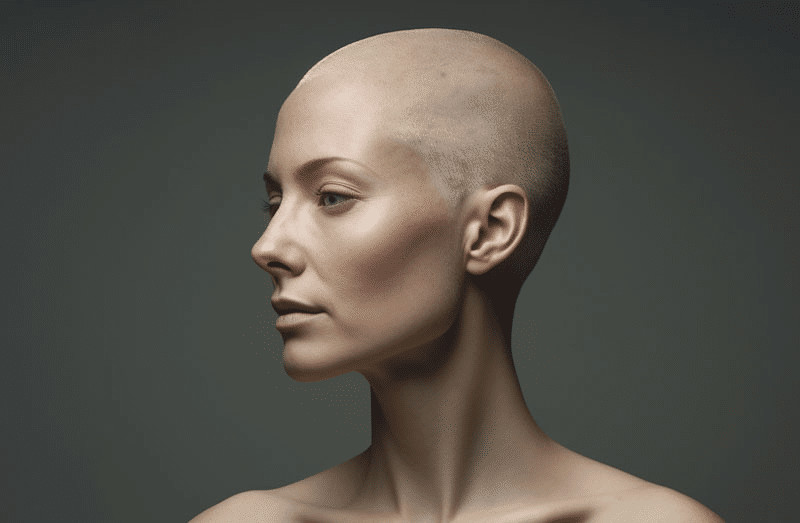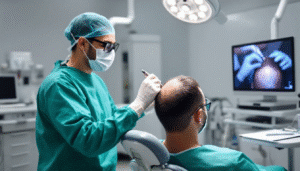Hair restoration therapy is considered an effective treatment for nearly 90% of the balding male population. While we would love to be able to clearly outline what to expect, hair transplant women before and after success stories vary. The factors that contribute to male vs female hair loss can be very different. As a result, the hair transplant women before and after rates of success differ as well.
Starting the journey of a hair transplant for women involves a significant decision driven by the desire for enhanced confidence and a positive shift in self-perception. The story of “hair transplant women before and after” unfolds as an exploration into the world of modern hair restoration techniques for women.
This journey covers the different reasons why women may experience hair loss, the personalized consultations guiding individualized solutions, the precise surgical process, and the emotional impact of the entire experience. Beyond the visible changes in appearance, this narrative reveals the emotional strength and newfound confidence that accompany the before-and-after stages of a woman’s hair transplant journey.
Female Hair Transplant Surgery Candidates

In order to be considered a good candidate for a hair transplant, you need to have enough healthy hair to transplant to the area of your scalp that needs new growth. You also need to be able to grow hair from the thinning areas of your scalp.
The best candidates for hair transplantation among women are those who are suffering from non-hormonal mechanical or traction alopecia. This occurs when too much strain is placed on the hair follicles from constantly wearing the hair pulled back into tight hairstyles, or over styling with harsh brushes and irons that aren’t well suited to your natural hair type.
Other good candidates include women who have had previous plastic surgery procedures such as facelifts. They may be concerned about hair loss near their incision sites.
Women who have a distinct pattern of baldness, similar to male pattern baldness make better candidates than women who suffer from diffuse hair loss. Diffuse hair loss entails thinning hair all over the head, which can make it more difficult to find enough stable donor hair sites at the sides and back of the head.
Different causes of hair loss in women

Hair loss in women can be attributed to a variety of factors, ranging from genetic and hormonal influences to lifestyle and medical conditions. Understanding these causes is crucial for effective diagnosis and personalized treatment. Here’s a comprehensive exploration of the different causes of hair loss in women:
Genetics

Hereditary factors play a significant role in female pattern hair loss. Genes inherited from either parent can influence the sensitivity of hair follicles to hormonal changes, leading to gradual thinning.
Hormonal Changes

Hormonal fluctuations at different life stages can contribute to hair loss. Hormonal fluctuations play a pivotal role in women’s hair loss. Events such as pregnancy, childbirth, menopause, or conditions like polycystic ovary syndrome (PCOS) can disrupt the hormonal balance.
Elevated androgens or changes in estrogen levels affect the normal hair growth cycle, leading to shedding. Hormonal shifts during pregnancy may lead to temporary hair thinning. Declining estrogen levels post-menopause can trigger hair loss.
Medical Conditions

Underlying health conditions can impact hair growth. Both hypothyroidism and hyperthyroidism can cause hair loss. An autoimmune condition where the immune system mistakenly attacks hair follicles.
Stress and Trauma

Physical or emotional stress can lead to hair shedding. Stress-induced hair loss (telogen effluvium) disrupts the normal hair growth cycle, causing a significant number of hairs to enter the resting phase.
Medications and Treatments

Certain medications may have hair loss as a side effect. Chemotherapy, radiation therapy, and medications for conditions like arthritis, depression, and heart problems can contribute to hair loss.
Environmental Factors

Environmental stressors can take a toll on hair health. Exposure to pollutants, harsh chemicals in hair products, and extreme weather conditions can weaken the hair shaft, making it more prone to breakage. Protective measures, such as using gentle products and minimizing exposure to pollutants, can help mitigate these effects.
Hairstyling and Practices

Overuse of hairstyling tools, tight hairstyles (like ponytails or braids), and frequent chemical treatments contribute to physical damage to the hair shaft. This damage weakens the hair, leading to breakage and eventual loss. Adopting gentle hairstyling practices and avoiding excessive heat and chemicals are crucial for preventing this type of hair loss.
Nutritional Deficiencies

Inadequate intake of essential nutrients, particularly iron, zinc, and vitamins A and D, can impact hair health. Poor nutrition disrupts the normal growth cycle, leading to excessive shedding.
Aging Process

Aging is a natural contributor to hair loss in women. As women age, there is a gradual thinning of hair due to factors such as hormonal changes and a decrease in the size of hair follicles. While this process is natural, maintaining overall health and adopting hair-friendly practices can mitigate the impact of aging on hair density.
Understanding the multifaceted causes of hair loss in women allows for targeted interventions and personalized treatment plans, emphasizing the importance of a comprehensive approach to address the underlying factors contributing to hair loss.
Recovery and Aftercare

Hair transplant surgery is a significant undertaking, and proper recovery and aftercare are crucial for achieving optimal results. This phase encompasses immediate postoperative care, short-term recovery, and long-term considerations. Here’s a detailed exploration:
Post-transplant Recovery Period and Potential Discomfort
Following the hair transplant procedure, the immediate postoperative phase spans the first 0-2 weeks. Patients may experience mild discomfort, swelling, and redness in the donor and recipient areas. Pain management prescribed by the surgeon helps alleviate any discomfort, while careful monitoring ensures the early detection of any complications.
Guidance on Aftercare Practices for Optimal Results

Hair Washing: Detailed instructions on when and how to wash the hair will be provided. Generally, patients can start gentle hair washing after a few days, using a mild shampoo recommended by the surgeon.
Avoiding Physical Strain: Patients are advised to avoid strenuous physical activities for a specified period to prevent undue stress on the transplanted hair follicles.
Prescribed Medications: Adherence to prescribed medications, including antibiotics and anti-inflammatory drugs, is essential for preventing infections and promoting healing.
Protecting the Scalp: Direct exposure to sunlight should be avoided, and patients may need to wear a hat or use sunscreen on the scalp when outdoors.
Follow-up Appointments: Scheduled follow-up appointments with the surgeon allow for the assessment of the healing process, addressing any concerns, and making adjustments if needed.
Emotional Support and Patience

Emotional Impact: Recognizing the emotional impact of the recovery phase is crucial. Hair shedding is a natural part of the process, and understanding this can alleviate anxiety.
Support System: Having a support system in place, whether through family, friends, or support groups, can contribute significantly to emotional well-being during recovery.
Patience in Results: While some immediate changes may be visible, the full results of a hair transplant take time. Patience is key, and understanding the gradual nature of hair growth is essential for mental well-being.
Long-Term Recovery and Beyond (6 Weeks Onward)
Resumption of Normal Activities: By the 6-week mark, most patients can gradually resume normal activities, including exercise and hairstyling. However, direct trauma to the scalp should still be avoided.
Monitoring Hair Growth: Patients continue to monitor the progress of hair growth. It’s common for transplanted hair to shed initially, with new growth beginning in subsequent months.
Postoperative Adjustments: Follow-up appointments may involve adjustments to the treatment plan based on how the hair is growing and any specific concerns the patient may have.
Recovery and aftercare are integral components of a successful hair transplant journey. Following the guidance of the surgical team, adopting a patient and attentive approach, and seeking emotional support contribute to a positive recovery experience and optimal long-term results.
DHT’s Relationship to Female Pattern Hair Loss

The occurrence of Dihydrotestosterone (DHT) is more prevalent in women. DHT causes the hair follicles to shrink, making it difficult to find suitable donor sites from which to graft follicles.
Follicles that are impacted by DHT are going to shrink and stop growing. It is important that the donor hair is coming from a stable site on the scalp otherwise the transplanted hair is just going to thin and fall out all over again.
Additionally, women that have suffered hair loss due to burns, scarring from accidents, or chemical burns are good candidates for hair transplants. Those who suffer from alopecia marginalis, a condition similar to traction alopecia that predominantly affects Black women, are also good candidates for hair transplants.
Hair Transplant Women Before and After

It can be difficult to trust hair transplant women before and after photos online. In our digital age, it is easy to manipulate images to sell a product or service that may or may not work.
A reputable plastic surgeon will provide plenty of well-lit before and after photos on their website that are consistent in quality. Additionally, you’ll be able to see examples of different hair types.
You will also be able to see photos of several different angles of the head, as well as before and after close-ups of the scalp. Furthermore, accompanying testimonials from real people is another good sign that you are choosing the right hair transplant service.
Women who get hair transplants typically struggle with hair loss around the frame of the face, as well as the crown of the head. The hairline may be receding around the widow’s peak and temples. There may also be an area of concentrated hair loss at the crown of the head before the procedure.
It is important to understand that even after transplantation, hair regrowth is a slow process. It can take up to two years for the newly transplanted hair to completely fill in. The typical timeframe is about 8-12 months but each person is different.
Female Hair Transplant Frequently Asked Questions

Can women of any age undergo a hair transplant?
Hair transplants are generally suitable for women experiencing pattern hair loss or thinning. However, the eligibility criteria depend on individual factors, and a consultation with a hair transplant specialist is essential.
Are the results of a hair transplant for women permanent?
Yes, the transplanted hair is typically permanent. However, the success may vary based on individual factors, and follow-up procedures may be recommended in some cases.
How long does it take to see noticeable results after a hair transplant?
The initial growth phase varies, but visible results can typically be observed within several months to a year after the procedure.
Can I color or style my transplanted hair after the procedure?
Once the transplanted hair has fully grown, it can be treated like natural hair, including coloring and styling. However, it’s advisable to consult with the surgeon before using any chemical treatments.
Female Hair Loss Can Be Solved With Hair Transplant Surgery

If you and your surgeon determine that you’re a good candidate for hair transplants, it’s important to understand that it can take up to a year for the new hair growth to become visible. The initial healing process is slow. Furthermore, it’s normal to lose hair at the transplant site in the initial months after surgery.
That’s nothing to worry about. But it takes effort afterward as well, just like dentistry. However, with patience and the help of a skilled surgeon, hair transplants can help restore your hair. Additionally, with time, and effort on your part, you can achieve a completely natural appearance.
Considering Surgical Treatment for Female Hair Restoration

In the dynamic landscape of hair restoration for women, the transformative journey from before to after is a narrative of empowerment and renewed self-confidence. The decision to undergo a hair transplant represents a profound commitment to reclaiming one’s identity and embracing the beauty of individuality.
As women navigate the intricacies of hair loss causes, the consultation process serves as a compass, guiding them towards personalized solutions that align with their unique needs and expectations. The surgical experience, marked by precision and artistry, lays the foundation for a gradual transformation that extends beyond physical changes.
The initial stages of recovery require patience and resilience, with emotional support playing a crucial role. As women tenderly care for their newly transplanted hair and witness the emergence of resilient strands, the journey becomes a celebration of self-discovery.
The Impact of Hair Loss Treatment in Women

Ultimately, the emotional impact of restored hair goes beyond aesthetics, influencing a profound shift in self-perception. The renewed confidence and joy in self-expression are not merely byproducts but integral facets of the aftercare and recovery process.
In conclusion, the before-and-after narrative in the realm of hair transplant for women is a testament to the empowerment found in embracing one’s authentic self. It’s a journey that transcends strands of hair, weaving a story of resilience, confidence, and the beauty of individuality. As women witness the unveiling of their revitalized hair, they step into a new chapter, where empowerment is not just a destination but a continuous evolution.

